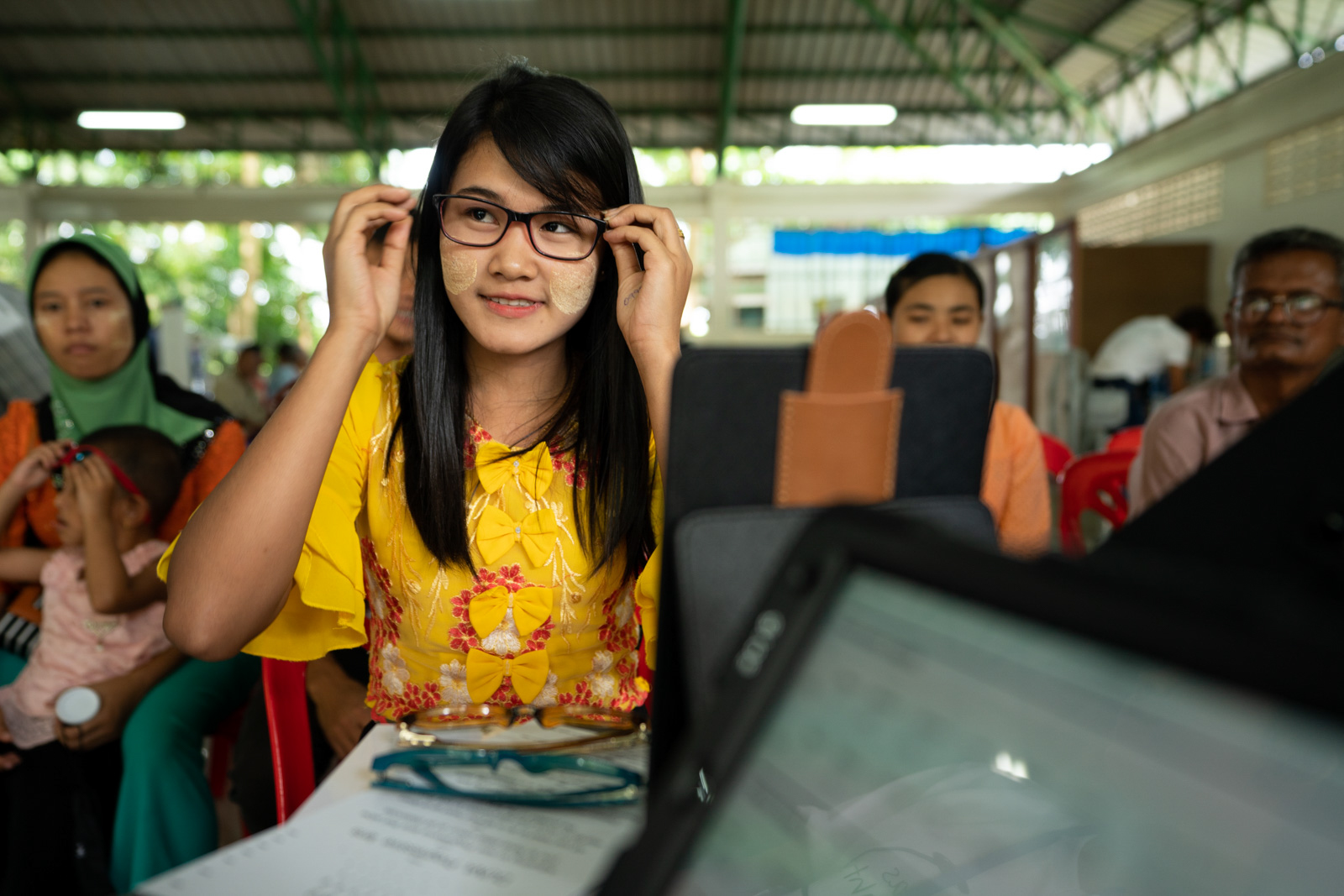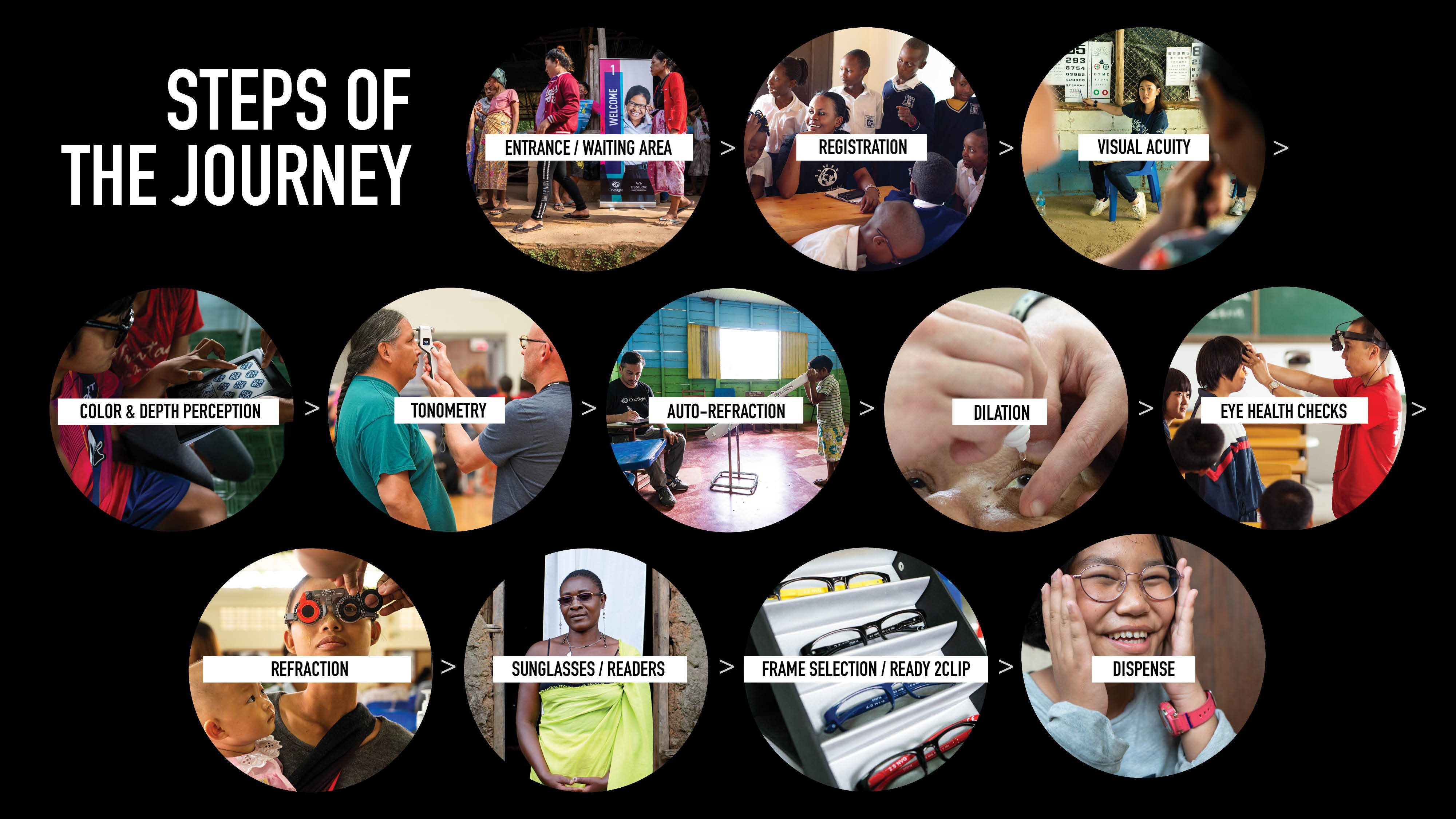
OneSight’s charitable clinics take both patients and volunteers on a special journey to help those in need get an eye exam and glasses. Each individual clinic is uniquely its own, bringing new energy, friendships, and faces through our doors.
For OneSight patients – whether returning or first-timers – the clinic experience can be a very exciting one. They may find themselves looking up at the familiar faces of their community members, or being served by people from the other side of the world. Some will receive a pair of prescription glasses that can radically change their life, others will learn about underlying eye health issues they never knew they had and how they can get help. It’s an experience we’re grateful to be a part of and one that we’re eager to share with more people in need around the world.
The following is a typical clinic flow, but every clinic has its nuances based on many factors.
A Patient’s Journey Through The Clinic

01 / Entrance/Waiting Area
For patients, the OneSight clinic experience begins as soon as they enter the clinic site. They’ll be welcomed through the entryway into a waiting area where they’ll wait for their turn to approach the registration station.
02 / Registration
Once patients reach the registration table, they’ll be greeted by OneSight volunteers who will help them get registered for the clinic. Before leaving registration, each patient will be handed a sticker that includes their name and a bar code for our team members to easily scan and track their eye health information throughout the entirety of the clinic process.
03 / Visual Acuity
The first eye test patients will be asked to participate in is a visual acuity test, otherwise known as the tumbling E chart. This will help the eye doctors assess a patient’s visual correction needs and give them a starting point for exploring possible prescriptions.
04 / Color & Depth Perception
Next, patients will put their color and depth perception skills to the test. They’ll be asked to pick out the numbers within a circle of dots of varying colors and sizes in what’s known as the Ishihara test. Additionally, they’ll undergo a stereopsis test to evaluate their depth perception.
05 / Tonometry
At the tonometry station, volunteers will test each patient’s eye pressure, which can help the doctors identify whether or not they’re at risk of developing glaucoma. To do this, the patient’s eyes are numbed with eye drops and a flat tipped probe is held closely to the eye. This probe will lightly poke the surface of the eyeball and instantly detect the eye’s pressure.
06 / Auto-Refraction
After eye pressure has been checked, it’s time to head to the auto refraction station! This station is a special one, as it will provide the eye doctors with a first glance at the patient’s refractive errors (which is used to generate their prescription glasses). Thanks to Adapatica’s Kaleidos technology – a magic machine that can automatically detect the refractive errors of both eyes in less than 3 seconds no matter the lighting condition – our team can screen patients very quickly at this station.
07 / Dilation
In preparation for seeing the eye doctor, dilation eye drops will be placed into patients eyes to allow doctors to see inside their eye and check for underlying eye health problems. Eyes can take some time to dilate, so patients can expect to spend at least 15-20 minutes waiting at the dilation station before moving on to their eye health check.
08 / Eye Health Checks
At the eye health check, OneSight volunteer eye doctors will use a special tool called a slit lens to look inside a patient’s eye. This health check can help to identify underlying health issues such as cataracts, diabetes, and more.
09 / Refraction
Finally, patients will make their way to the refraction station where eye doctors will work with them to determine a prescription for their new glasses. In this vision test, doctors will be able to identify conditions such as astigmatism, hyperopia, myopia, and presbyopia. This test can also help to diagnose conditions such as macular degeneration and retinal detachment.
10 / Sunglasses/Readers
In some regions, OneSight clinics will feature a sunglasses and reading glasses station to help provide locals with protective and low Rx eyewear. The sunglasses can be especially helpful for patients living in sunny communities that lack any means to protect their eyes from harmful UV rays.
11 / Frame Selection/Ready2Clip
Once all vision tests have been completed and a prescription has been determined, it’s time for patients to pick out their new glasses. This station is where personality and individuality shine through as patients explore the dozens of different shapes, colors, and styles of our frames. Once they select a frame they love, our volunteers will adjust them to fit each patient’s face and will insert the prescription lenses. When someone loves their frames, they’ll feel more confident and that helps with wear frequency.
Whenever possible, our volunteers will add prescription lenses to the frames onsite. However, in some cases, prescriptions will need to be fitted in an off-site lab. When this happens, patients may need to wait a few weeks for their new glasses to be made and shipped.
12 / Dispense
At last, patients will have made it to the most exciting portion of the clinic journey – dispense. This is the moment in which glasses are given to their new owner and patients light up with joy as they glance at themselves in the mirror with their new specs on.
For us, it’s the moment that makes every challenge worth it and gives us a glimpse of the magic behind our mission. The look on a patient’s face when they leave our clinic with their new glasses is one of joy, hope, confidence – and so much more.